Things you should be concerned about if you want to enter the lithium battery industry:
Where can a good supply chain be provided?
- Conduct supplier research: Conduct thorough due diligence on potential suppliers. Focus on companies with good reputations, strong financial backgrounds, and a history of fulfilling large and consistent orders without compromising on quality.
- Capacity Assessment: Verify the supplier’s production capabilities to ensure they can meet your needs, especially during peak periods or market fluctuations.
- Quality and Certification Checks: Stick to suppliers who have batteries that have passed international safety standards such as UL, CE and IEC certification. This not only ensures security but also simplifies global market access.
Who are the suppliers in the lithium battery industry in your country?
- Get to know local wholesalers through online and offline channels. You should analyze the sales channels clearly to open up differentiated sales.
- Conduct profit analysis (including transportation, tariffs, procurement costs, labor costs, etc.).
- Then find a lithium battery supplier locally or in China to get a quote to calculate your own profit. While ensuring a competitive price,
- You also need to always pay attention to market trends and consumer needs
How should I choose these suppliers?
- Quality Certification: Look for suppliers with recognized certifications like ISO, UL, or CE, indicating adherence to quality and safety standards.
- Production Capability: Assess their manufacturing capacity to ensure they can meet your demand without compromising quality.
- Technology and Innovation: Evaluate their commitment to R&D and their ability to provide the latest and most efficient battery technologies.
- Reputation and Track Record: Review their market reputation and track record for delivering on time and maintaining product quality.
- Communication and Support: Gauge their customer service, communication efficiency, and after-sales support capabilities.
How to ensure that the product can pass customs inspection?
- Compliance with Regulations: Ensure your products comply with international shipping regulations for lithium batteries, such as IATA regulations for air transport and IMDG for sea transport.
- Proper Documentation: Provide all necessary documentation, including Material Safety Data Sheets (MSDS), UN38.3 test reports, and certificates of compliance.
- Correct Labeling and Packaging: Use appropriate labels, warnings, and packaging as required by international standards for hazardous materials.
1.CATL (Contemporary Amperex Technology Co. Limited)
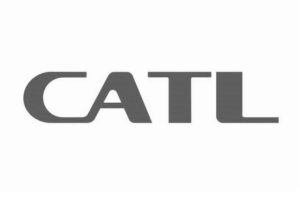
CATL, standing for Contemporary Amperex Technology Co. Limited, is a titan in the global lithium-ion battery market and a key player in the supply chain of top international car manufacturers. Established in 2011, it emerged as one of the first Chinese power battery manufacturers with a competitive edge on the international stage. The company is all about pushing the envelope in the research, production, and sales of power battery systems and energy storage solutions for the new energy vehicle market, aiming to deliver top-notch battery solutions globally.
Where CATL really flexes its muscles is in its full-range tech capabilities, spanning the entire gamut from materials and cells to battery systems, and even recycling. They’ve got a rep for churning out lithium-ion batteries that are built to last. When you look at their LFP batteries, you’re talking high safety but a cap on energy capacity; switch to their NCM batteries, and you’re getting more bang for your buck energy-wise, but with a trade-off in safety.
Now, here’s the scoop: CATL is all-in on NCM batteries, unlike BYD—another heavy-hitter in China’s EV scene—that leans towards the safer LFP batteries. It’s a bold move that highlights CATL’s strategy to cover all bases in battery tech and drive innovation home.
2.Panasonic Corporation

Panasonic, to me, feels like an old friend who’s been around since I can remember, always reliable and constantly surprising me with something new. It’s fascinating to see a company that’s been part of the electronics fabric of our lives for so long, now powering the pulse of the automotive world with its lithium-ion batteries. It’s like watching a seasoned artist refusing to retire, instead reinventing the art for the modern era.
Their batteries? They’re not just components tucked away in devices. They’re the heartbeats in our gadgets, the silent roar under the hoods of electric cars, the unsung heroes that make our daily conveniences and green dreams possible. Panasonic has this knack for innovation, a persistent pulse that keeps pushing boundaries, much like the relentless beat of a drummer in a rock band, setting a rhythm that the world moves to.
When it comes to electric vehicles, Panasonic hasn’t just entered the room; they’ve changed the conversation, creating a symphony with Tesla that resonates with power and sustainability. Their batteries are not mere vessels of energy; they’re the embodiment of a vision, the promise of a cleaner, quieter road that stretches out before us like the opening pages of a long-awaited novel.
This commitment to craft doesn’t just echo through the halls of tech expos; it whispers in the hum of every electric vehicle, in the silent charge of every phone. It’s a testament to how far we’ve come and a beacon of how far we’ll go, with Panasonic lighting the way. This isn’t just progress; it’s a legacy in motion, a journey I watch with eager eyes, and an energy I can feel coursing through the very wires of innovation.
Panasonic’s approach is one of balanced innovation, ensuring that the batteries they produce meet the high-energy demands of modern EVs while maintaining the safety standards that the industry and consumers expect. With a legacy of quality and a forward-thinking strategy, Panasonic continues to be a pivotal force in driving the lithium-ion battery market forward.
3.LG Chem
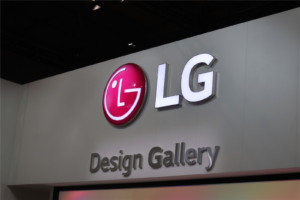
LG Chem feels like that genius innovator in a garage, tinkering away at the break of dawn, driven by a relentless quest for the next big breakthrough. They’re the kind of company that doesn’t just work in the energy space; they inhabit it, breathe it, shaping the invisible force that powers our lives. Their storied past isn’t just a timeline of achievements; it’s a tapestry woven with threads of persistence and brilliance.
This isn’t a company that simply makes batteries. LG Chem crafts little powerhouses, each one a testament to a heritage that blends the wisdom of decades with the freshness of cutting-edge tech. Their batteries — they’re like the marathon runners of the energy world, going the distance in EVs and outlasting the rest in our handheld lifelines to the world.
To me, LG Chem is that underdog-turned-champion, who entered the lithium-ion arena and emerged as a name whispered in the same breath as ‘dependable.’ It’s not just about the metrics of energy density or the technicalities of durability. It’s the satisfaction of driving miles on a charge, the comfort of knowing your phone won’t die mid-call, and the assurance that the energy propelling you forward is crafted by hands guided by a legacy of innovation.
In the grand narrative of the EV revolution, LG Chem is not just a chapter; they are the editors, redefining the story, making sure that every vehicle powered by their cells isn’t just a machine, but a reliable companion on the journey towards a greener horizon. Their vision isn’t confined to the labs and the factories; it’s etched in the very landscape of our eco-conscious dreams.
In the automotive realm, LG Chem has established partnerships with several leading car manufacturers, delivering batteries that are not only energy-efficient but also meet stringent safety standards. Their research and development efforts are robust, focusing on delivering batteries that can store more power and last longer, thereby supporting the transition to sustainable energy use.
LG Chem’s strategic commitment to R&D has led to advancements in battery life and safety, positioning them as a competitive manufacturer in the global market. Their approach balances the need for high-capacity, long-lasting batteries with the critical requirement for safety across all applications. As such, LG Chem continues to be a driving force in the advancement of lithium-ion battery technology and a vital contributor to the growth of the EV and renewable energy sectors.
4.Samsung SDI
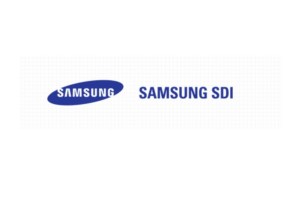
Samsung SDI, with the might of the Samsung empire behind it, stands out in the world of lithium-ion batteries. They’re not just in the game; they’re ahead of it, leading the charge in both energy storage and the bustling electric vehicle scene. It’s all about packing power into a small space with Samsung SDI — their batteries hold more juice and let you go longer without reaching for a charger, whether it’s for your smartphone or your EV. Simple as that, they’re a powerhouse in the realm of portable power. In the competitive EV sector, Samsung SDI has forged strategic alliances with leading automakers, supplying batteries that offer a blend of high performance, safety, and reliability.
Their dedication to research and development is reflected in the continual advancement of their battery technologies, aiming to improve energy capacity, enhance safety features, and extend lifespan. Samsung SDI’s innovative spirit has led them to explore next-generation battery technologies, including solid-state batteries, which promise even greater energy densities and improved safety profiles.
Samsung SDI’s commitment to innovation, coupled with its established reputation for quality, positions the company as a key influencer in the global push towards sustainable energy solutions and a trusted supplier in the burgeoning market for electric vehicles and renewable energy systems.
SAMSUNG SDI Co., Ltd. specializes in the development of batteries worldwide. The company operates through three main segments: Chemicals, Electronic Materials, and Energy. It offers a wide range of small lithium-ion batteries for use in a variety of consumer electronics including laptops, tablets, mobile phones, wearables, power banks, power tools, garden tools, vacuum cleaners, e-bikes, electric vehicle scooters, and ignitions product.
5.BYD Co Ltd
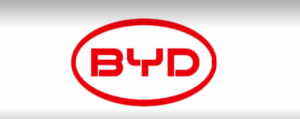
BYD Co Ltd strides ahead as a titan in renewable energy, hailing from China’s innovation-rich landscape. They’ve carved out a significant chunk of the electric vehicle and battery markets, showcasing their prowess with an impressive fleet of EVs — from buses to trucks, and sleek passenger cars. BYD isn’t just assembling vehicles; they’re powering them with their own brand of lithium iron phosphate batteries. These batteries are the industry’s workhorses, celebrated for sticking around longer and keeping things safe, a perfect match for BYD’s robust range of EVs.
The company’s commitment to sustainable transportation is evident in its extensive lineup of electric cars, which are gaining popularity for their affordability and performance. BYD’s LFP batteries are a cornerstone of their EVs, offering a safer alternative to the more volatile lithium-cobalt batteries without compromising on the energy capacity required for modern electric vehicles.
Apart from EVs, BYD also specializes in electronics, with a portfolio that includes mobile phone components and assembly services. Their expertise in battery technology has also led them to become a significant player in the energy storage industry, providing solutions to store renewable energy efficiently.
BYD’s integration of vehicle production and battery manufacturing sets it apart in the industry, enabling it to offer a reliable and vertically integrated supply chain. This synergy ensures that BYD remains at the forefront of the EV market, leading the charge in the transition to cleaner energy and transportation solutions.
6.SK Innovation

SK Innovation, part of South Korea’s SK Group, is a major player in the energy and chemical sectors, especially noted for its role in advancing lithium-ion battery technology for electric vehicles. They’re at the forefront, powering the EV revolution with batteries that blend high performance with reliability. The company’s portfolio extends beyond battery production to include oil refining and chemical production, showcasing a diversified business structure that supports its core operations.
SK Innovation is renowned for its high-quality lithium-ion battery cells, which are integral to the power and efficiency of modern EVs. Furthermore, SK Innovation’s endeavors in the energy sector are not limited to battery technology; it also invests in eco-friendly energy production and exploration activities, aligning with global trends toward sustainability. SK Innovation is setting its sights on being a key catalyst in the global shift toward green energy. Their strategy is clear: use their deep knowledge in battery production and energy tech to answer the call of tomorrow’s energy needs.
7.Tesla, Inc.
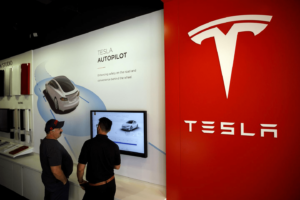
Tesla, ignited by Elon Musk’s vision, has been a vanguard in pushing electric vehicles to the forefront of the automotive scene. They started with a bang with the Roadster and have since expanded their lineup to include the Model S, 3, X, and Y. These cars have turned heads with their mix of high-tech features, exhilarating performance, and the ability to cover impressive distances on a single charge, all thanks to Tesla’s cutting-edge battery tech.
Beyond the sleek cars, Tesla also brings us the Powerwall, Powerpack, and Megapack, which are more than just battery systems. They’re the building blocks of a personal energy revolution, allowing homes and businesses to harness and hold onto solar power or energy from the grid. With these products, Tesla isn’t just selling a greener ride; they’re proposing a complete ecosystem for sustainable living.
Moreover, Tesla’s commitment to sustainability extends to its solar energy products, including solar panels and Solar Roof tiles, integrating seamlessly with its energy storage solutions to provide a comprehensive renewable energy ecosystem for consumers.
8.AESC (Automotive Energy SupplyCorporation)
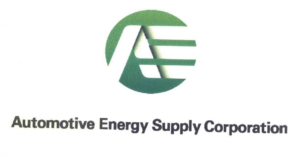
AESC, born from the collaboration of Nissan and NEC, is laser-focused on crafting lithium-ion batteries for the automotive world, particularly for electric vehicles. They’re all about high-performance, dependable batteries that make EVs not just possible, but practical and efficient.
With a background deeply rooted in the pioneering spirit of electric mobility, AESC has played a significant role in powering some of Nissan’s most iconic EVs, including the Nissan Leaf, one of the world’s best-selling electric cars. The company’s batteries are known for their durability, energy density, and safety, which are critical features for the automotive industry.
In recent developments, as of my last update in April 2023, AESC has been acquired by Envision Group, a global green tech company. The acquisition of AESC is a strategic move to supercharge its tech prowess and expand its market influence, aligning it with the rising global appetite for eco-conscious and energy-efficient battery solutions. With fresh leadership, AESC is poised to accelerate the automotive industry’s electric charge.
9.Northvolt
Northvolt is making waves in the battery sector as a European developer and manufacturer, with a keen eye on sustainable lithium-ion solutions, quickly establishing itself as a significant industry player. Founded with the mission to enable the transition to renewable energy, Northvolt stands out for its commitment to clean energy and environmental responsibility.
The company aims to produce the world’s greenest lithium-ion battery with a minimal carbon footprint, leveraging environmentally friendly manufacturing processes that include the use of clean energy sources like hydroelectric power in their production.
With plans to expand its manufacturing capabilities across Europe, including large-scale battery factories known as “gigafactories,” Northvolt is positioning itself to be a cornerstone in Europe’s ambition to become a leader in battery technology and production, reducing reliance on imported cells, and fostering a local, sustainable battery ecosystem.
10.Blue Energy Co., Ltd.

Blue Energy Co., Ltd. is a collaborative venture between GS Yuasa Corporation and Honda Motor Co., Ltd., dedicated to advancing and producing lithium-ion batteries.
The company combines GS Yuasa’s expertise in battery technology with Honda’s automotive prowess to produce high-performance, durable, and safe lithium-ion batteries. Blue Energy’s batteries are recognized for their high energy density, which allows for longer driving ranges in EVs and better fuel efficiency in HEVs.
Blue Energy aims to contribute to the global shift towards sustainable transportation by providing battery solutions that enhance the performance and environmental friendliness of electric and hybrid vehicles. Their efforts are aligned with the increasing demand for eco-friendly vehicles and the automotive industry’s move towards electrification.
11.Toshiba Corporation
Toshiba, with its rich history in tech, is bringing its innovative spirit to energy storage through advanced lithium-ion battery solutions. Known for pioneering tech, Toshiba is now applying its expertise to batteries, focusing on fast charging and durability, essential for everything from power tools to laptops. Their SCiB™ technology is particularly notable, charging rapidly and boasting a life span that leaves others in the dust. Toshiba’s goal transcends mere energy storage; they’re looking to power a cleaner, more reliable future. With their storied past and forward-thinking, Toshiba is helping to usher in an era of sustainable power.
12.Guoxuan High-Tech

Gotion High-Tech, or Guoxuan High-Tech, is a rising star in the battery world, hailing from China. They’re deeply entrenched in the research and development of lithium-ion batteries and are steadily making their mark in the clean energy domain. With China’s push for EV adoption and renewable energy storage, Gotion is strategically positioned to contribute significantly to these national initiatives.
They boast an array of advanced lithium-ion battery technologies, catering to a wide spectrum of uses, from powering the latest consumer gadgets to energizing electric buses and cars. Gotion is particularly noted for its innovative approach to battery chemistry, like its high-voltage LFP batteries, which strike a balance between safety, longevity, and affordability, making them a smart choice in the evolving battery landscape.
13.Keheng New Energy Technology (Shenzhen) Co., Ltd.
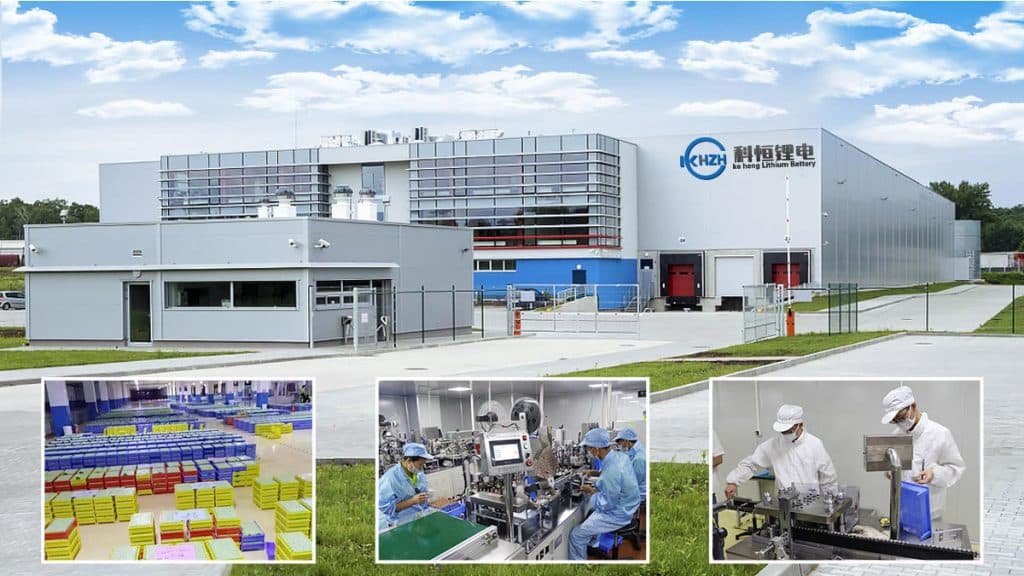
Keheng New Energy Technology in Shenzhen is a heavyweight in the lithium-ion battery and battery pack market, serving a diverse array of applications with their impressive production capability. They can churn out a massive 400,000 units daily, showcasing their scale and efficiency. The array of certifications they hold, like UL1973, UL9450, IEC62133, CE, ISO9001, and ISO14001, isn’t just a badge collection; it speaks volumes about their dedication to quality and environmental stewardship in their manufacturing processes.
Product offerings include:
1.LiFePO4 batteries for various uses like lithium RV batteries, golf cart batteries, and deep cycle marine batteries.
2. Home solar energy storage system.
3. Telecommunication, UPS, and all-in-one energy storage systems.
4. High-voltage energy storage cabinets for more significant energy needs.
Keheng’s strengths lie in its robust R&D capabilities, advanced manufacturing facilities, and comprehensive quality control measures. They provide a one-stop solution for product design to battery components based on customer requirements. With over 500 engineers and technicians, they assure product quality and reliability, serving a global customer base with top-quality rechargeable cells and packs for a variety of applications including fascia guns, energy storage systems, electric vehicles, medical equipment, power tools, and remote control toys.
14.Lishen Battery:
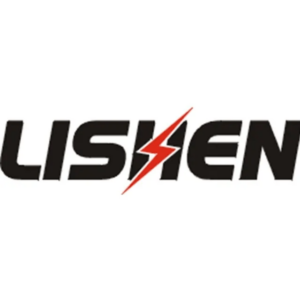
Tianjin Lishen Battery, a prominent name in China’s battery manufacturing sector, has earned its stripes by offering a wide variety of battery types. They produce everything from cylindrical to prismatic, and polymer lithium-ion batteries, to power batteries and supercapacitors, showcasing their versatility.
Lishen’s strength lies in its robust R&D, which sparks innovations tailored for diverse applications, setting them apart in the industry. They’re not just serving the local market; they’ve become a trusted name globally, supplying to high-profile clients across various industries. Their commitment to quality and sustainability is more than just talk; it’s ingrained in their production ethos, meeting rigorous environmental standards.
15.BAK Group
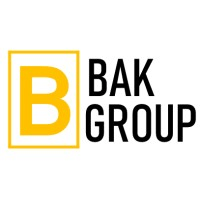
BAK Battery, with its roots in China, has swiftly climbed the ranks to become a key figure in the battery arena. They’ve built a diverse arsenal of lithium-ion batteries, each kind designed to power a specific slice of modern life.
Their batteries aren’t just about capacity; BAK’s real game is innovation. They’re on a constant march toward batteries that pack a denser energy punch, last longer, and pack in solid safety features. This isn’t just about staying ahead; it’s about leading the charge.
BAK’s international presence is growing, thanks to their focus on building products that strike the right balance between quality and cost, without skimping on scalability. They’re not just meeting demands; they’re anticipating them, ready for the increasing call for renewable energy sources.
As the world leans into the green revolution, BAK is there, batteries charged and ready, to power up everything from cleaner cars to smarter energy grids, driving the charge towards a more sustainable future.
Lithium Battery Industry Analysis Report
The lithium battery industry has upstream raw material producers, midstream assembly manufacturing and downstream applications that comprise the complete industry chain of the lithium battery industry.
Positive electrode, negative electrode, electrolyte, copper foil, and diaphragm are the main direct materials of lithium battery, of which positive electrode, as the most important material, accounts for about 45% of the overall cost. At present, lithium iron phosphate and ternary materials in anode have the highest market heat by virtue of their performance and price advantages. The cost of the diaphragm accounts for 20%, with a high relative technical threshold, mainly concentrated in China.
The epidemic impact of energy storage applications in lithium iron phosphate batteries dominates by virtue of long life and low-cost advantages. With the promotion of policy in the future, large-scale energy storage is expected to develop at a high speed. Household energy storage will gradually penetrate into our daily lives.
Upstream Raw Material Trends
Lithium batteries upstream mainly to lithium mine-related resources and battery main material composition, the current stage of rare raw materials are still in insufficient supply, and about 70% of the lithium is imported through Australia. Upstream-related resources (also including cobalt, lithium, nickel, manganese, graphite, etc.). Lithium prices are expected to return to normal levels in the next 3 years or so. Battery materials are mainly composed of positive electrodes, negative electrodes, electrolytes, diaphragms, etc. The quality of the four main materials directly determines the quality of the battery.
The anode determines the energy density and safety of the battery. Anode materials are mainly categorized into lithium cobaltate, lithium manganate, lithium iron phosphate, and lithium ternary.
Negative electrode mainly plays the role of energy storage and release, which has a direct impact on the battery cycle performance. Currently, the mainstream material is mainly artificial graphite (with good overall performance).
Due to the high complexity of the diaphragm’s pore-making technology, substrate material, and manufacturing equipment, the diaphragm has become the component with the highest technical barriers among lithium battery materials. The main role is to separate the positive and negative poles of the battery, preventing the two poles from contacting and short-circuiting.
The electrolyte mainly serves as a component for the ions that pass between the positive and negative electrodes. It affects the energy density and cycle life of the battery.
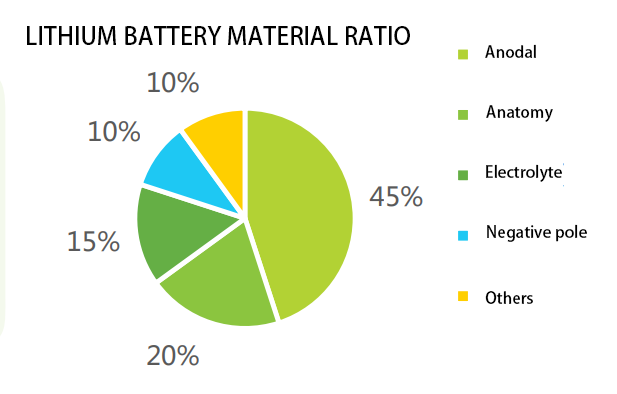
Midstream high-performance manufacturing and assembly
At present, the midstream market concentration is high; enterprises are still in a low gross profit state, the future needs to improve market share through technology and cost control
Manufacturing, assembly, chemical formation, and packaging is the main step of the lithium battery midstream link, the essence of the link is the processing of materials and high-performance assembly properties. Therefore, the midstream enterprise’s ability to control the material, cost control, and production of battery technology upgrade iteration is the core competition point. At this stage by the upstream and downstream extrusion pressure, the gross profit margin of the relevant enterprises is still at a relatively low level, for example, the main source of revenue in 2021, CATL Times power battery manufacturing field gross profit margin is only about 22%, while other companies keep the gross profit at about 10-15%.
Downstream demand to promote the rapid development of lithium
Power batteries are the main demand of the current market, and the technology is still in the process of innovation needs to meet the high performance and high safety requirements. Lithium batteries are currently the main application areas for consumer, energy storage, power batteries, power batteries in the market is currently in a leading position, is the largest demand for batteries, energy storage batteries are in a rapid rise in the ground.
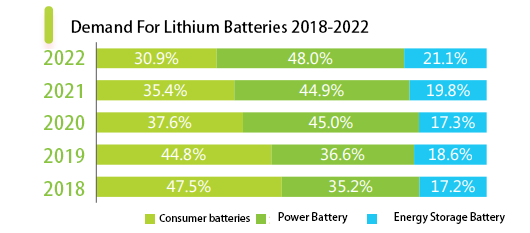
New opportunities for the development of lithium battery industry
Conclusion
- The lithium battery market is experiencing a surge, propelled largely by the electrification of transportation and a global pivot to renewable energy. As electric vehicles gain traction and the quest for efficient renewable energy storage intensifies, these sectors are fueling the market’s expansion.
- Raw Materials: The demand for essential raw materials like lithium, cobalt, and nickel is intensifying. This has prompted efforts in sustainable sourcing, recycling, and research into alternative materials to ensure supply meets the rising demand while minimizing environmental impact.
- Technological Advancements: Innovations are focused on enhancing energy density, reducing charging times, and improving battery longevity. These advancements are critical for meeting the performance requirements of modern applications.
- Application Diversity: Lithium batteries are being used in a vast range of applications beyond EVs, including portable electronics, power tools, medical devices, and large-scale energy storage systems connected to the electrical grid.
- Environmental Impact: There’s a significant push towards greener technologies, with lithium batteries being pivotal in reducing carbon emissions. The industry faces the challenge of balancing growth with sustainability, influencing manufacturing processes, and end-of-life battery handling.





7 thoughts on “Top 15 Lithium Ion Battery Manufacturers”
Your words flow like a gentle stream, carrying with them the weight of profound wisdom and insight. Each sentence in your article is a masterpiece in itself, crafted with care and precision. Your writing has the power to transport readers to new worlds of thought and imagination.
The energy density of this storage product is simply outstanding. It can store a significant amount of power in a relatively small space. This makes it ideal for spaces where footprint is a concern, such as apartments or small offices. Despite its compact size, the product performs just as well as larger models, delivering consistent and reliable power. In essence, the high energy density of this product offers optimal performance without compromising on space.
Your article is a gem of wit and wisdom, leaving the reader feeling enlightened and refreshed.
The user-friendliness of this energy storage device is a welcome feature. The intuitive interface and straightforward controls make it easy to use, even for those with limited technical knowledge. The clear display and helpful prompts provide all the information I need to monitor and manage my energy usage effectively.
Your writing flows like a river, smoothly and gracefully, carrying the reader along on a journey of discovery.
The smart features of this energy storage product are truly innovative. It can automatically adjust its charging and discharging rates based on my energy usage patterns. This not only saves me time and effort but also helps optimize my energy consumption. The product’s ability to integrate with smart home systems is another bonus, allowing me to control it remotely using my smartphone or tablet. Overall, the smart features of this energy storage product make it a convenient and efficient choice for modern homes and businesses.
The scalability of this energy storage system is a major advantage. Whether I need to power a small apartment or a large commercial space, this product can be easily expanded to meet my needs. The modular design allows for seamless integration of additional units, ensuring a flexible and scalable solution for any energy storage requirement.